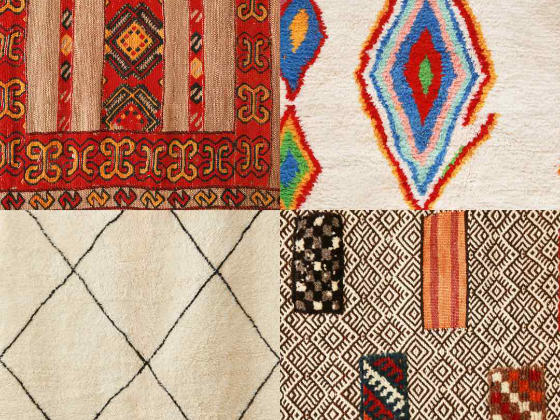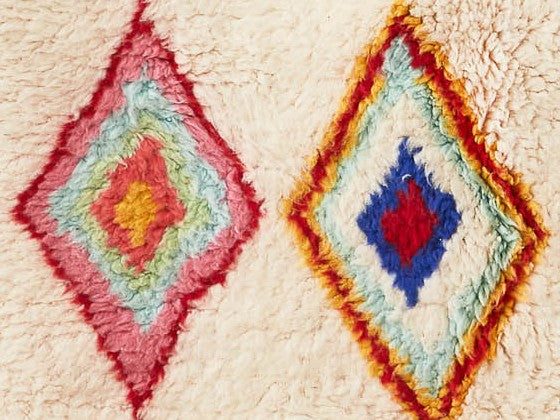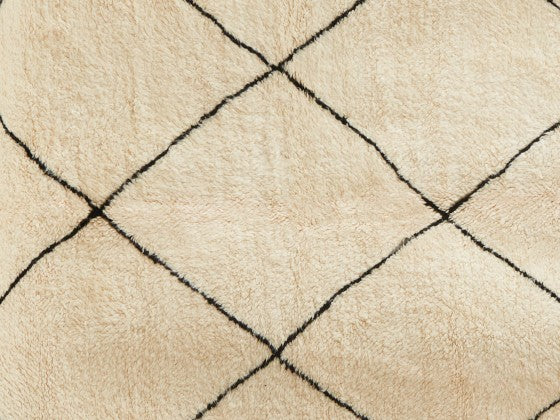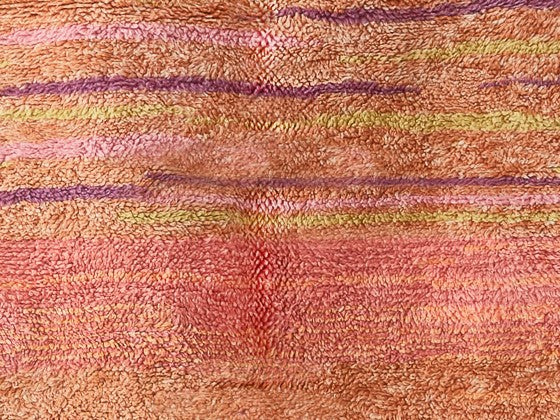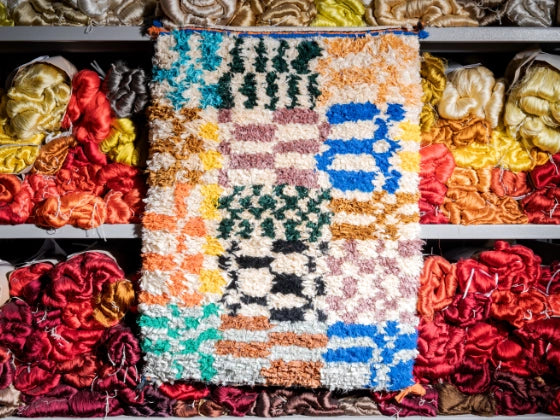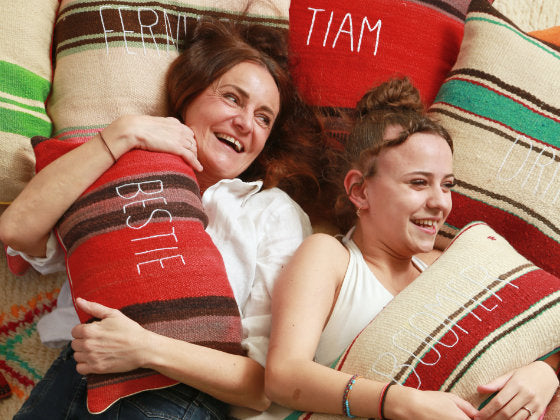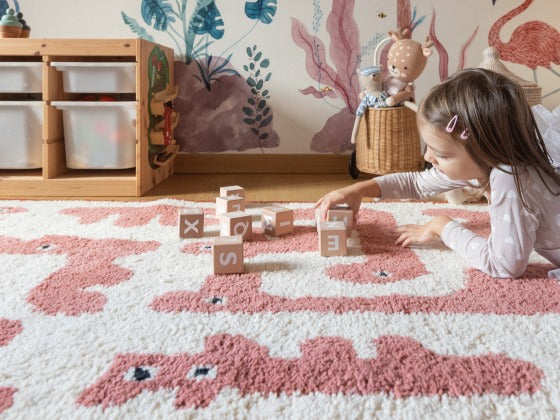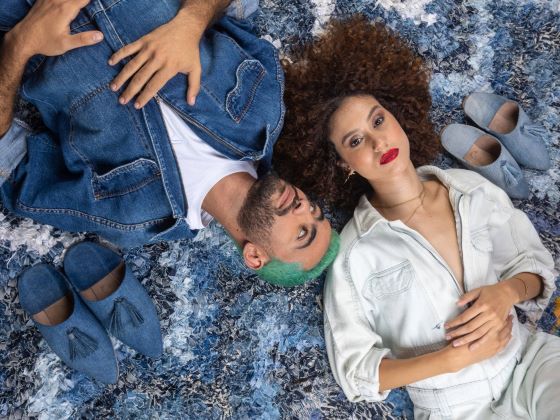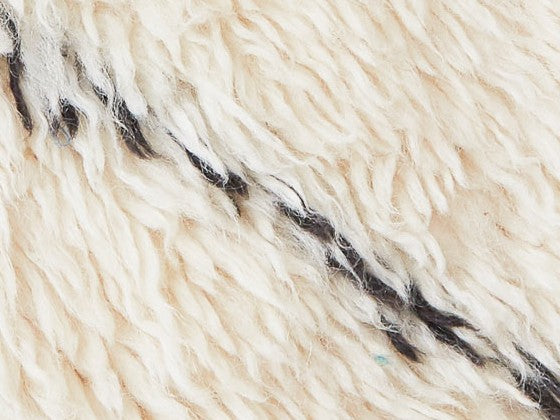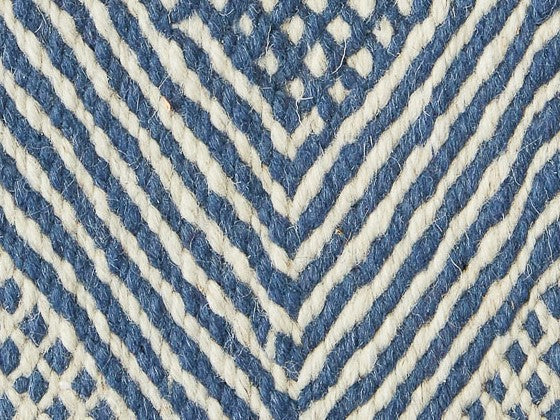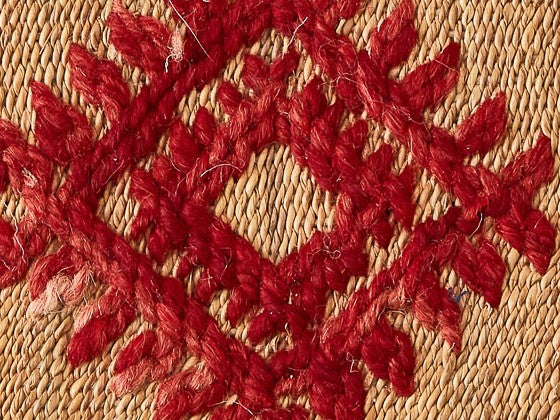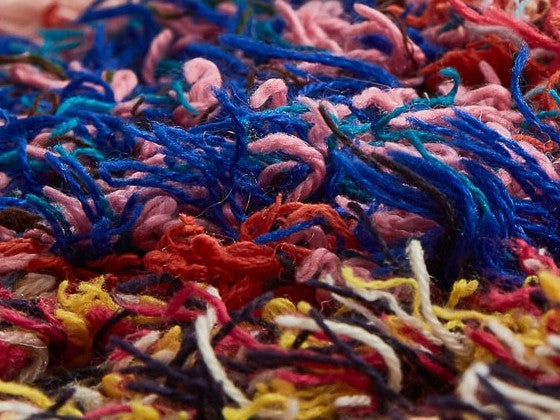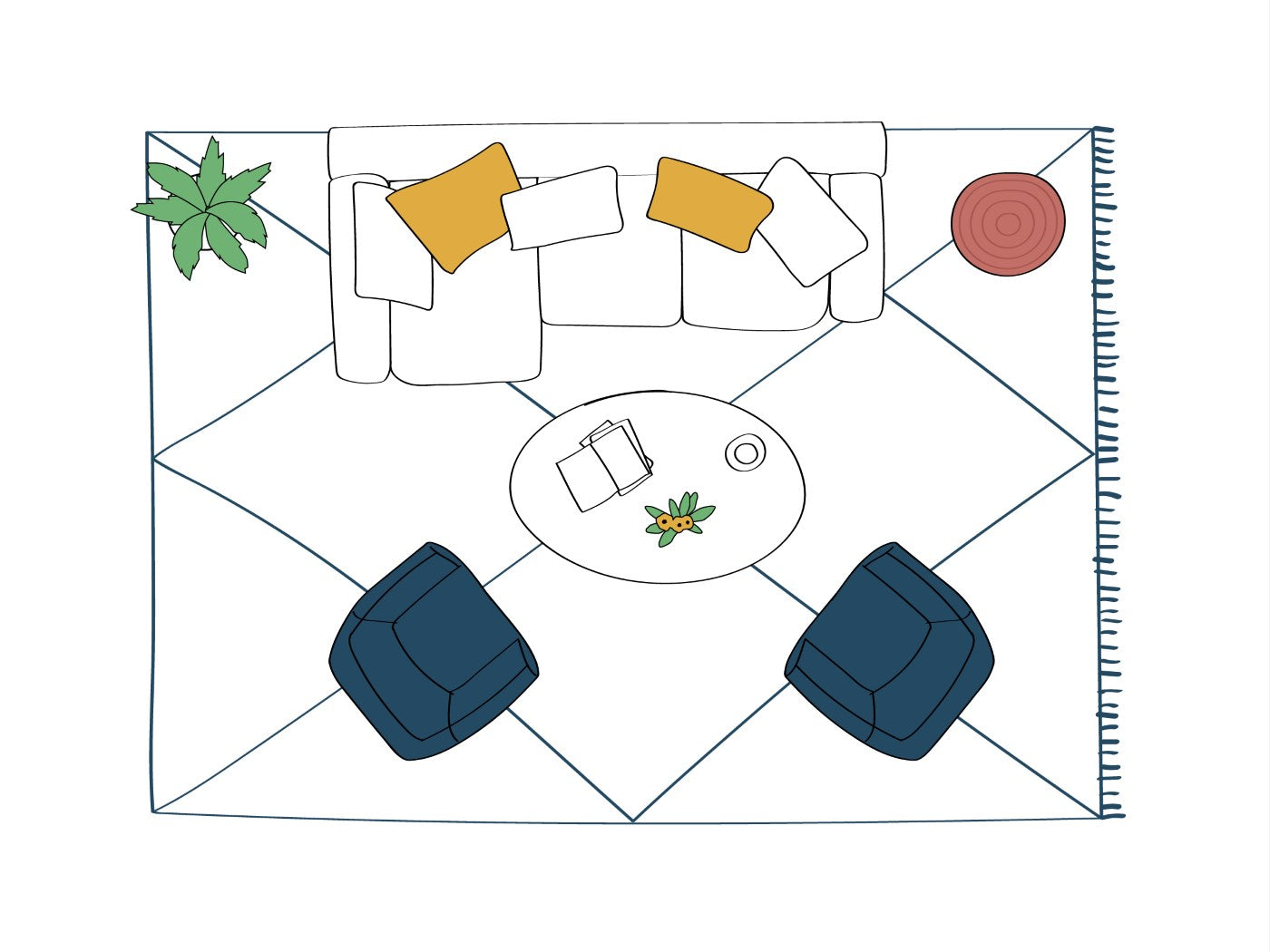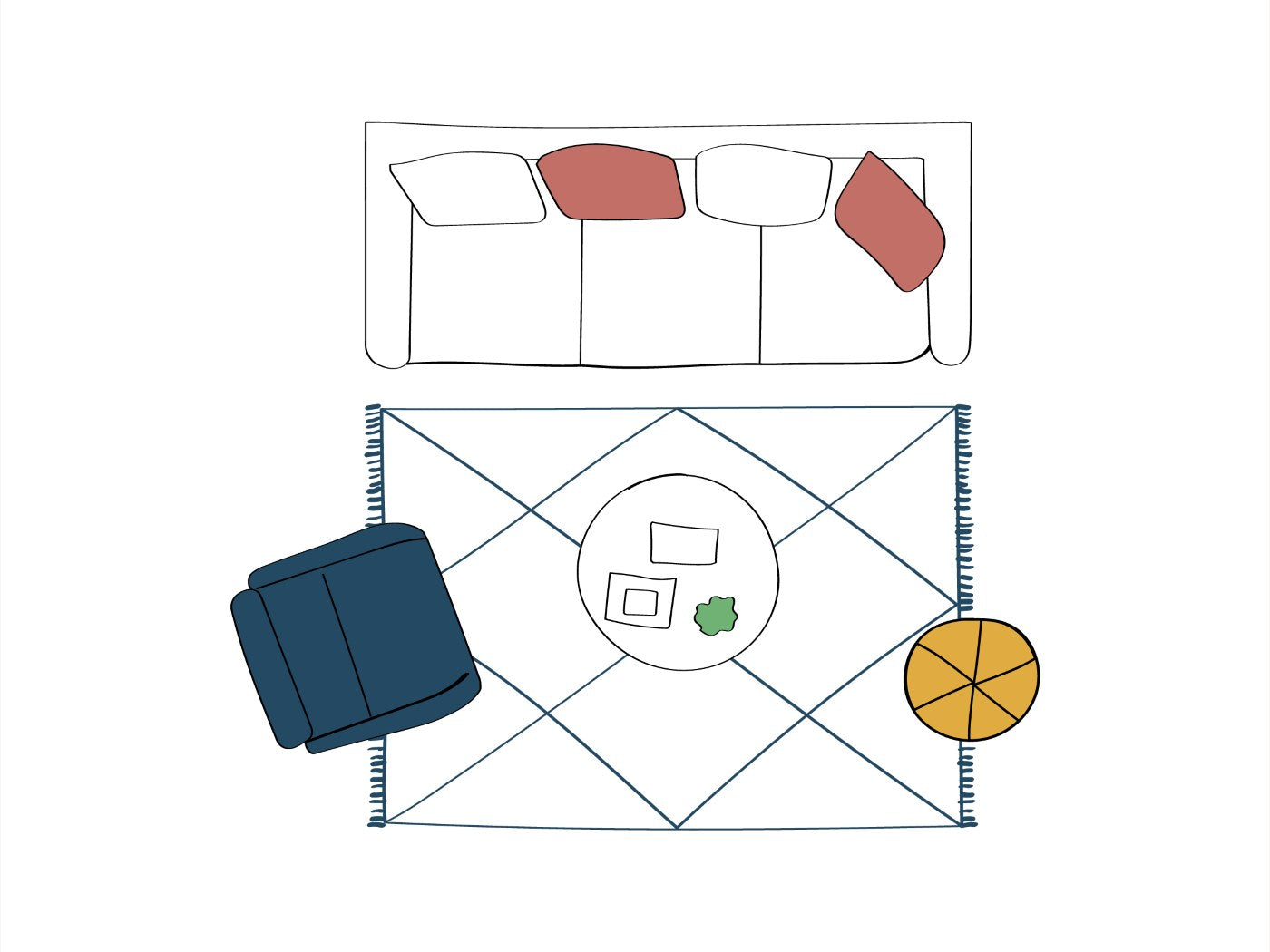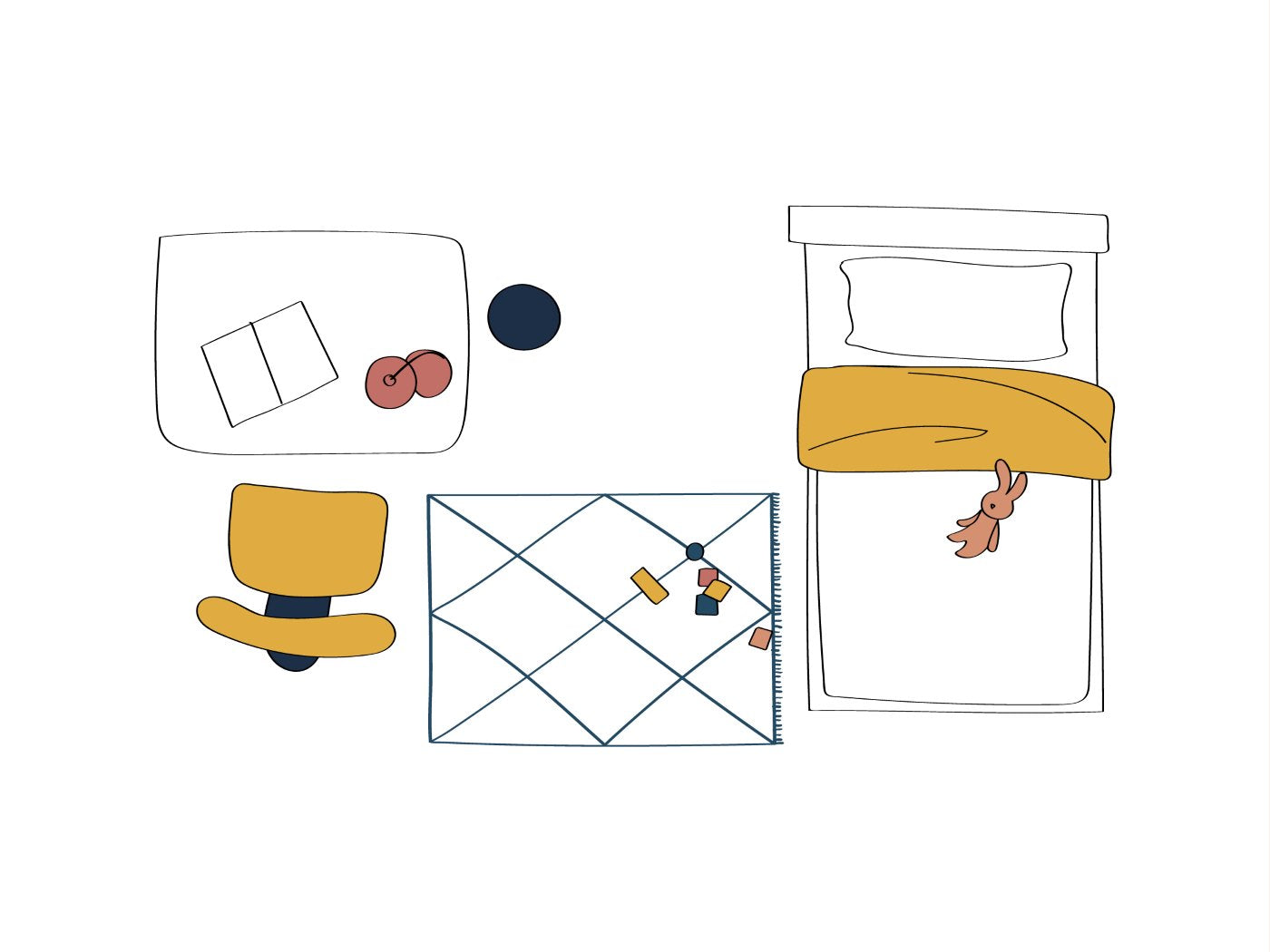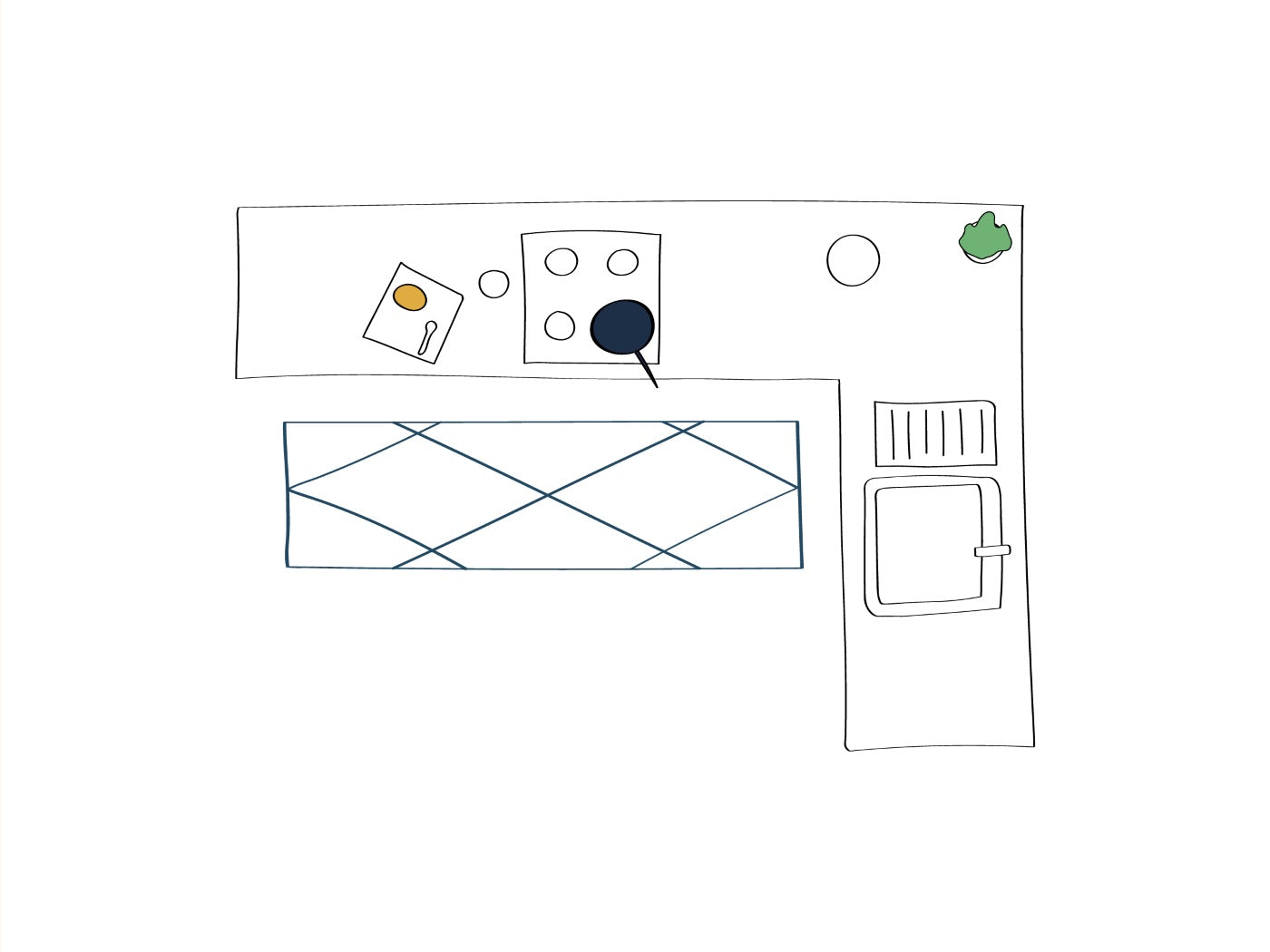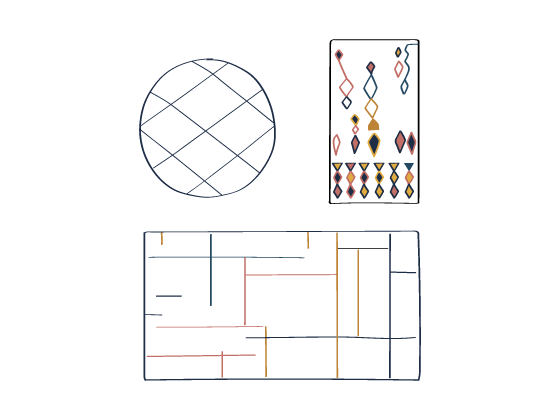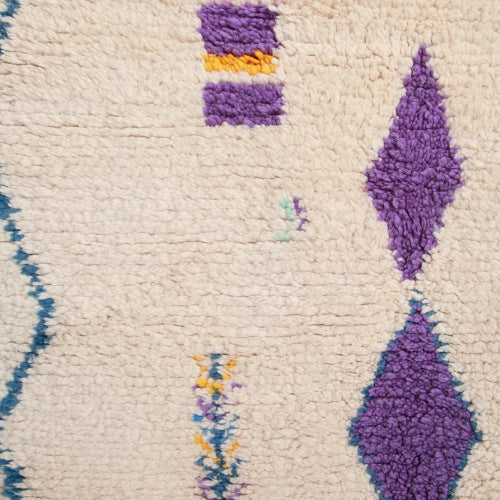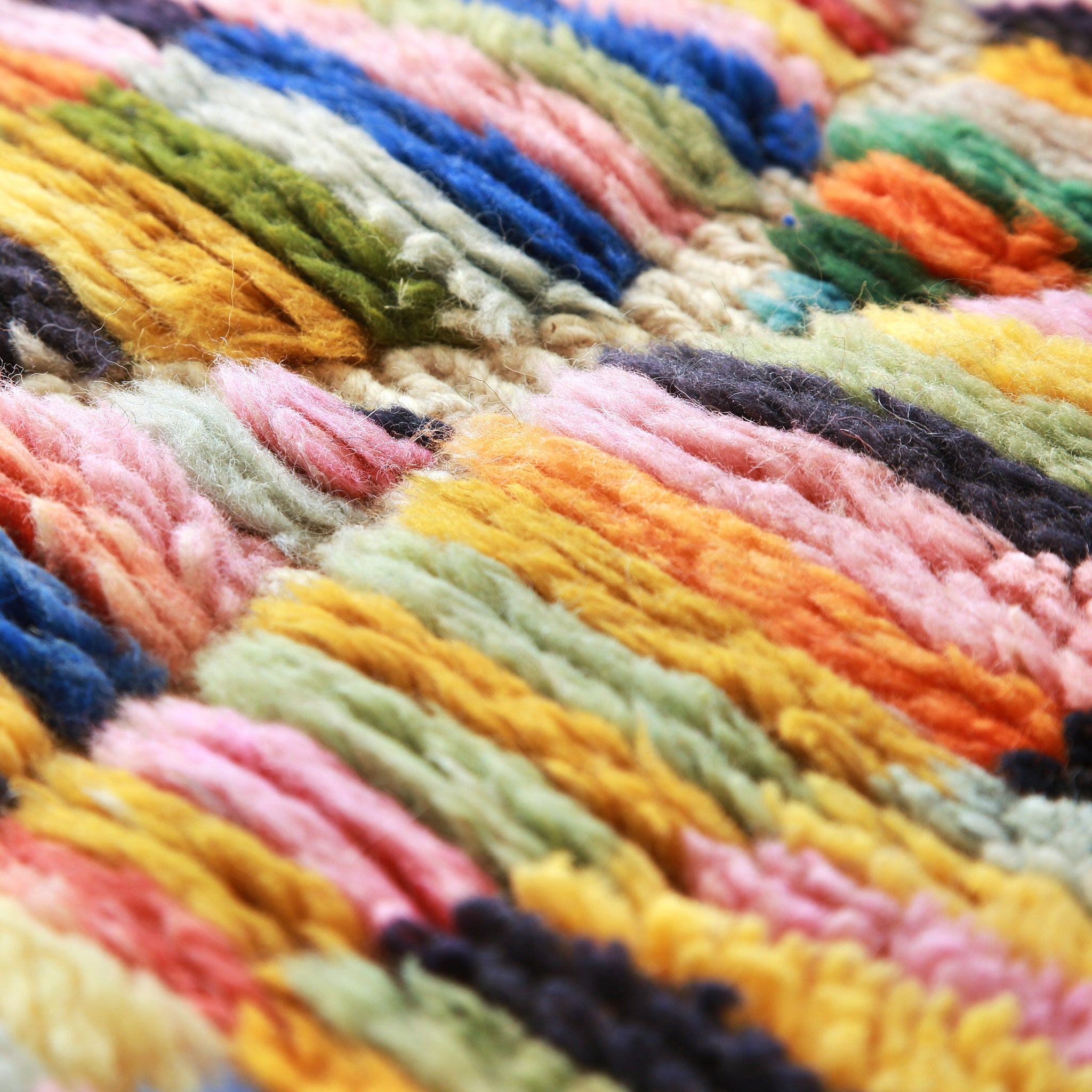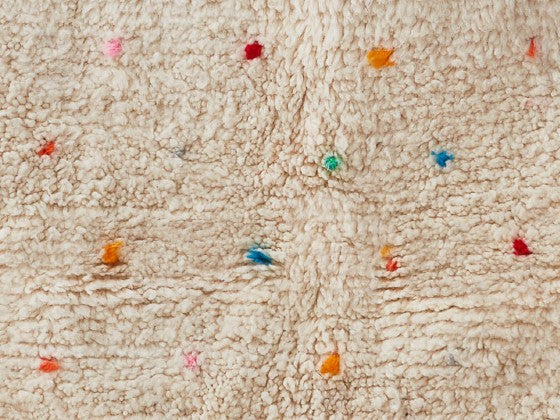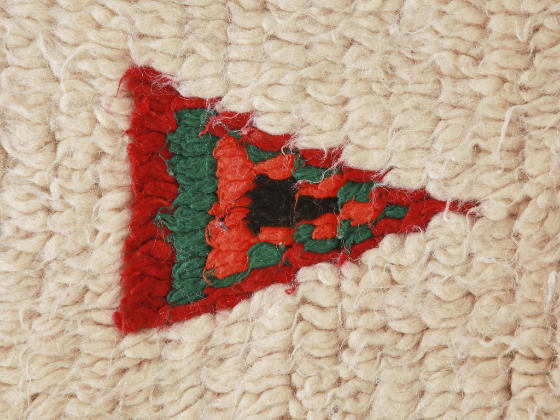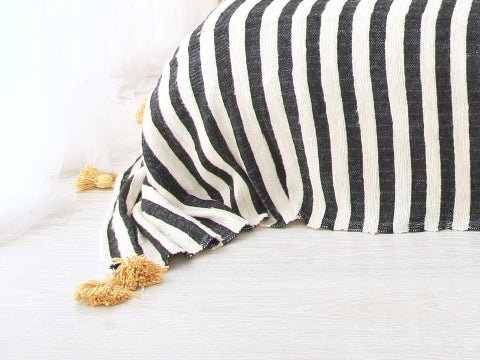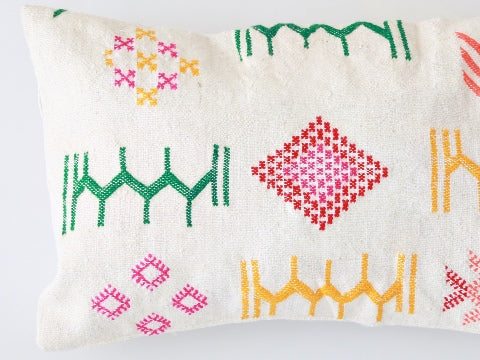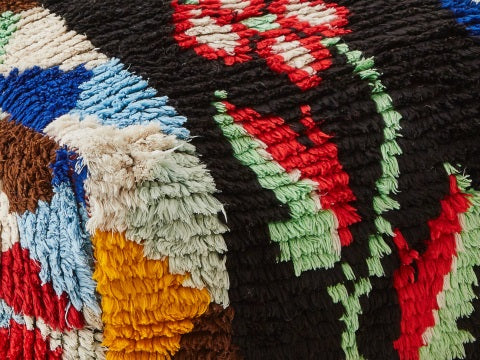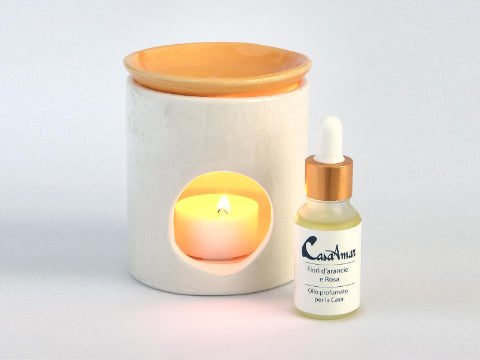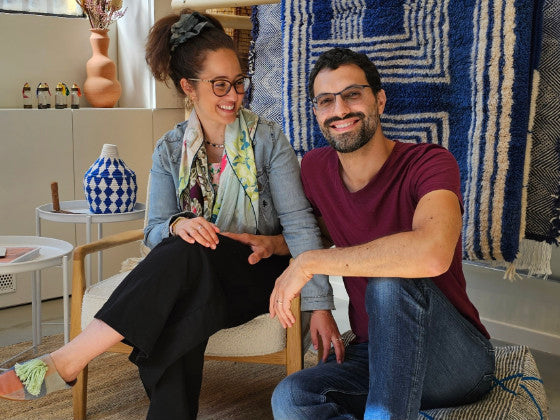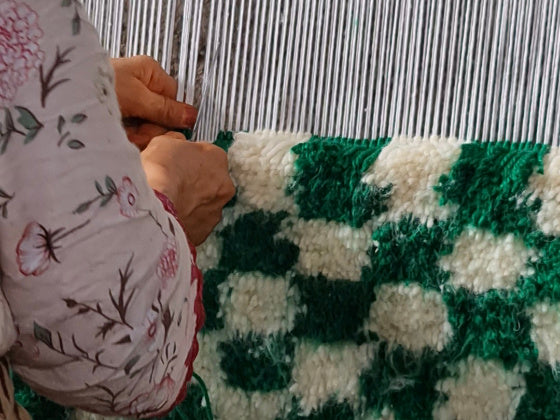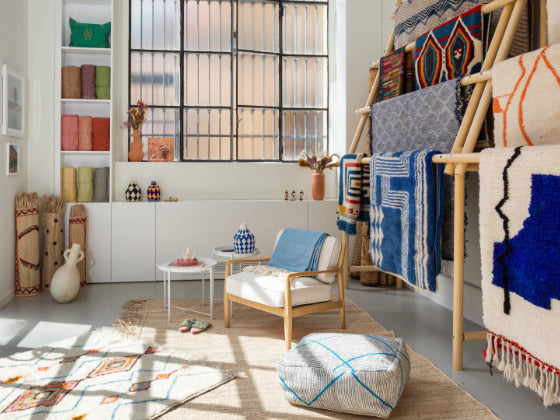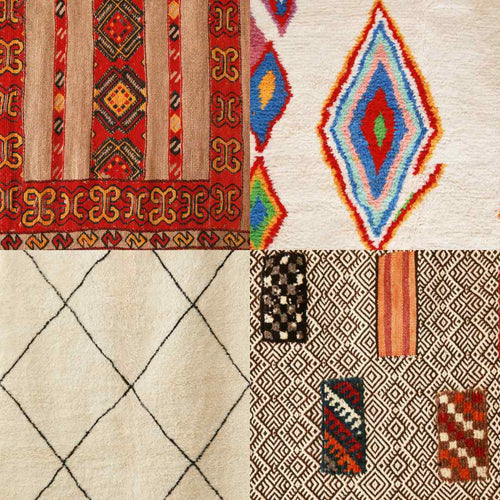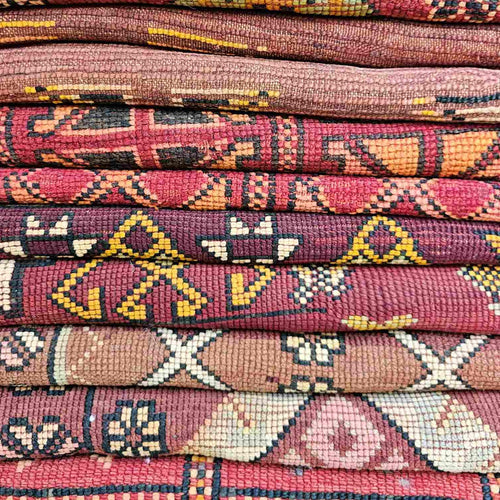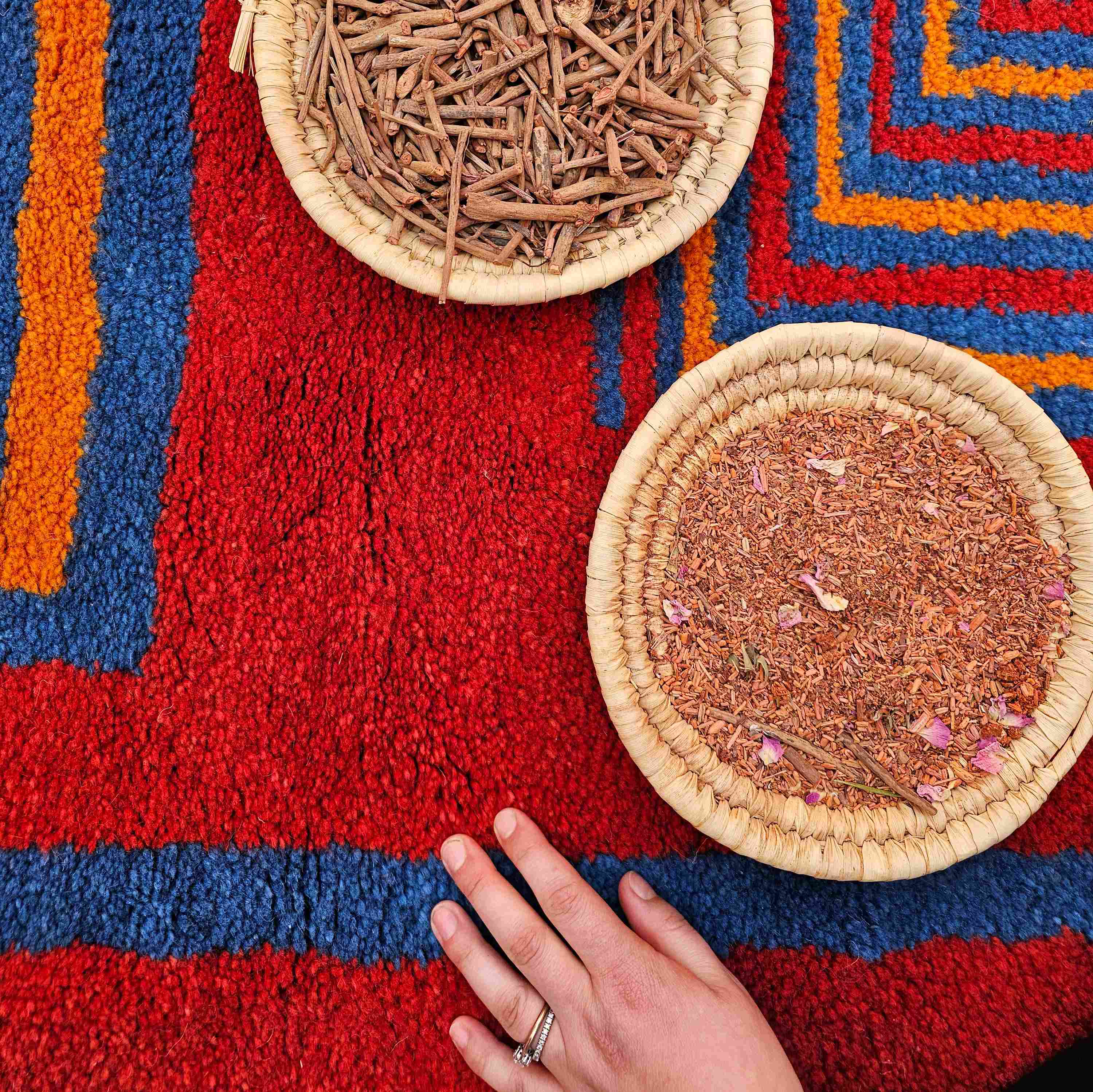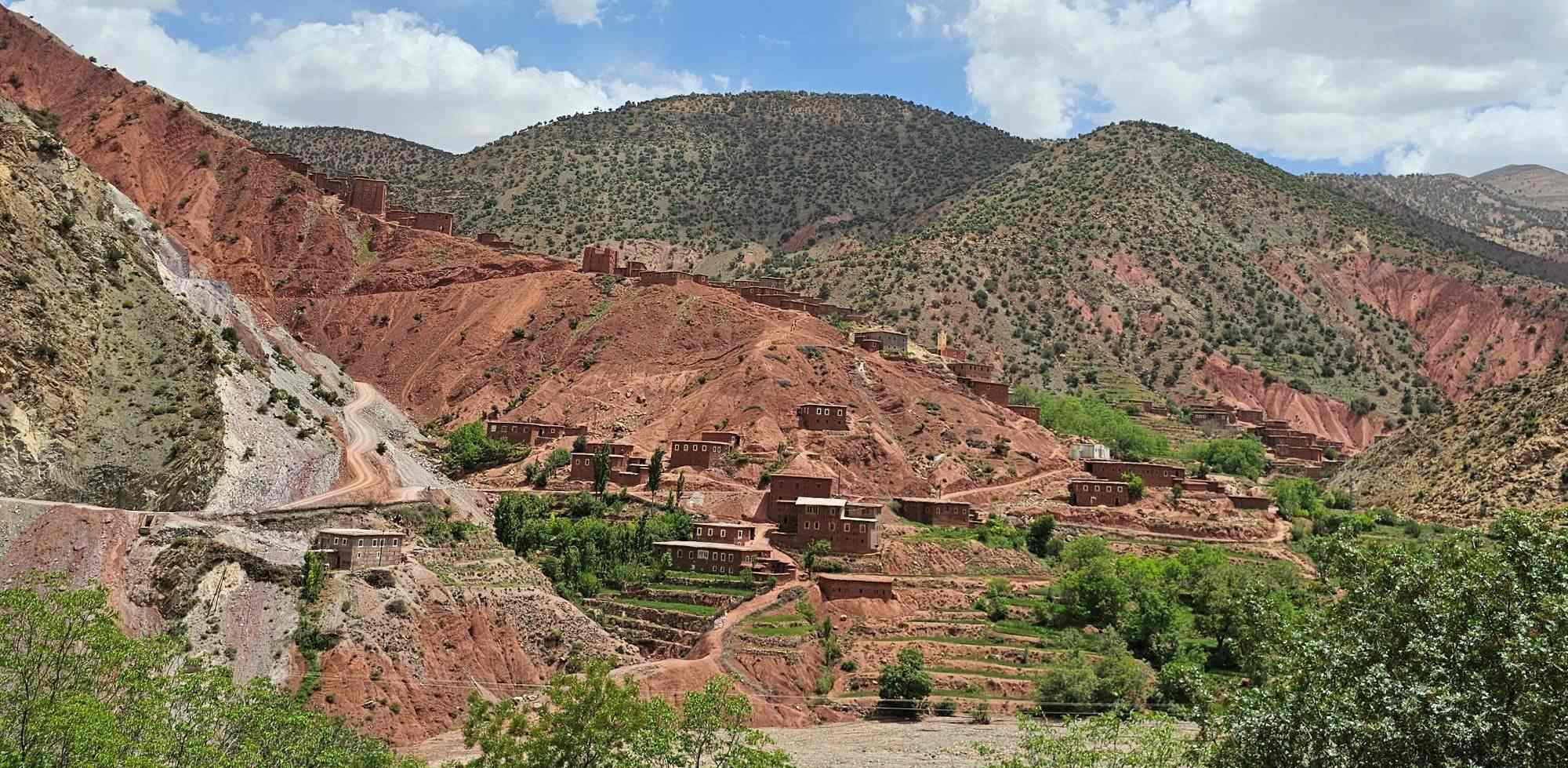This post is a real immersion in the world of Moroccan rugs: a sort of maxi glossary, a complete guide to orient yourself among the many types of Moroccan rugs in existence, to know them in depth and choose them with greater awareness. We can imagine it almost as an itinerant journey -why not- on a flying rug, transported to the heart of a fascinating and ancient culture: that of Morocco.
We will understand the differences between Moroccan rugs and Berber rugs, we will learn not to fall into the error of trivially defining them as ethnic rugs, we will discover what gives the name to each type of rug, and we will know their characteristics and workmanship.
Shall we go?
Here’s what we’ll find out:
- All the names of rugs produced in Morocco: an introduction
- Beni Ourain
- Kilim (or better) Hanbel
- Mrirt's Goods
- Boucherouite
- Boujaad
- Azilal
- Taznakht
- Zanafi
- Akhnif
- Kharita
- Hassira Mat
- Glaoui
- Chichaoua
- Zemmour
- Zayane
- Zindech
All the names of rugs produced in Morocco
It may seem almost superfluous to specify it but what defines a Moroccan rug is first of all its provenance: it is not (only) a type of decoration or a workmanship or, even, a fabric.
To define a rug as a Moroccan rug, the artifact must be made in Morocco. Does it seem obvious? But it is not and now we will explain why .
Although it may seem like an obvious statement, in fact, it often happens to come across, even online, "Moroccan rugs" or rather, sold as such but which are actually produced in Pakistan, India, Turkey...
Be careful because in these cases there are some risks.
Often they are completely industrial or only partially handcrafted rugs, which use Amazigh designs even though they have nothing to do with original Moroccan rugs. Furthermore, the production methods, the materials used and the treatment reserved for workers are very questionable.
Berber? Amazigh? Moroccan? Let's get some clarity.
Let's start with the basics: a Moroccan rug is a handcrafted rug made in a very specific geographical area , which corresponds to present-day Morocco, or the north-western part of the Maghreb located near the Atlas mountain range.
The original populations of North Africa (Morocco, Tunisia, Algeria) define themselves, in their language, “Imazighen” or “Amazigh” (Amaziɣ ⴰⵎⴰⵣⵉⵖ), that is, “free people” .
The word Berber, on the other hand, was introduced by the Arabs when they colonized the area, to indicate all the indigenous populations. It derives from the Greek “bárbaros” and the Latin “barbarus”, and gave rise to the word barbarian, with a negative connotation.
Moroccan rugs are different from African rugs produced in other areas of the Maghreb, such as Tunisian or Egyptian ones. The art of hand-knotting rugs, in fact, dates back to very ancient times in Morocco - it seems to be the 8th century - well ahead of the development of the same techniques in other North African countries. But the massive diffusion occurred in the last few centuries, with the start of commercialization and - in the 20th century - thanks to the interest of internationally renowned designers and artists such as Le Corbusier, Alvar Aalto, Paul Klee . We will talk about them in other in-depth articles.
It is also useful to remember that the artisans who work the rugs - yes, because it has always been a predominantly female activity - are not all Berber / Amazigh: so be careful not to confuse the terms. If we refer to the origin of a rug, we can speak of an Amazigh rug only when it has Amazigh origins (as in the case of the Beni Ourain or the Beni Mrirt, who were once Amazigh tribes).
The origins: the tribes, the wool, the ancestral techniques, the motifs and symbols
The art of rug making originated in the Atlas Mountains (ⵉⴷⵓⵔⴰⵔ ⵏ ⵓⴰⵟⵍⴰⵙ, Idurar n Waṭlas; in Arabic جبال الأطلس, Jibāl Al-Aṭlas), where the nomadic and semi-nomadic “Berber” tribes dedicated to pastoralism settled. Influenced by contact with Persian traders and favored by the quality of the wool of local sheep, they began to produce rugs, initially intended for daily and private use and only later for sale.
Even today, Moroccan rugs use almost exclusively sheep's wool , although the use of dromedary or goat wool is not excluded, especially for vintage rugs. This exceptional wool, soft and bright with a typical ivory color, is then colored with natural or plant-derived pigments. Alternatively, undyed black or dark wool can also be used.
To recap.
The history of Moroccan rugs is therefore linked to that of the tribes (which no longer exist today, contrary to what is sometimes read) who have passed down the millenary tradition of artisanal weaving, from generation to generation, from family to family, keeping intact until today styles, techniques, workmanship, knowledge and symbolism. The geometric and symbolic motifs on rugs can represent scenes of daily life or of their personal history, stories of fertility, nature and femininity. The advent of Islam then influenced the decorative aspect of rugs by introducing arabesque and geometric motifs , giving life to unique artefacts with an inimitable style.
Each rug tells a unique story, conveying the social status, origin and spiritual beliefs of the weaver on the fabric. Each piece is a unique work of art, woven with skill, patience and creativity, an indecipherable secret that often only the weaver herself can decipher.
We also explained it here: Why do we say Amazigh and not Berber?
Uses and functions of the rug
What for us is often just an interior design item, for these populations was (and is) wealth, tradition, history, investment (of time and money), work, family, community.
Let us explain why we are not just talking about an object.
It is a real cultural heritage rich in value and symbolism, which still today represents the deep connection with the long Moroccan history.
Traditionally, in fact, the rug has taken on different functions depending on the place or local culture, functions that link practicality and spirituality.
The climatic conditions of Morocco made rugs essential - being soft and warm because they were made of wool - for thermal insulation (both from heat and cold): this is why they were used for different purposes, acting as a blanket for the bed, a rug, a mattress or a covering/decoration for the nomads' tents .
Rugs were also used for funeral shrouds or as saddle blankets, to make the saddle more comfortable.
Not to mention the small, portable version for prayer .
The use of it as a tapestry for vertical wall decoration , however, has more to do with aesthetic motivations, such as those that today lead to the inclusion of floor rugs in homes.
Materials and workmanship
There are many types of Moroccan rugs, which differ from each other based on the type of knotting, the decorative pattern, the colors used and the texture of the fabric.
Depending on the type of manufacturing , Moroccan rugs can be long-haired or flat-woven , but there are also rugs made from recycled fabrics created by upcycling textile leftovers.
In most cases, Moroccan-style rugs use wool or virgin wool as the main material, coming from local sheep, knotted and dyed by hand. However, other natural fabrics such as cotton or silk can also be used, so among Moroccan rugs we also find straw and wooden mats .
Weavers use horizontal or vertical looms and often follow weaving techniques, traditions and designs passed down from generation to generation. They often do not follow designs or plans, continuing instinctively thanks to the skills and knowledge developed over time, thus creating unique and unrepeatable artifacts.
Colors and patterns
Moroccan rugs are known for their vibrant colors and geometric patterns on light or white backgrounds (the natural color of wool). There are also multicolored wool ones , as well as those decorated with diamond and diamond shapes, which are very popular.
As we will see in this post, each rug has its own characteristics and uniqueness: we will discover them little by little and learn to distinguish them.
Beni Ourain

Beni Ourain (or Beni Ouarain) are probably the best-known Moroccan rugs, brought to the fore in recent years by the prevailing Nordic design which has made this black diamond pattern on a white background a must-have.
They take their name from a group of Amazigh tribes from the North East of Morocco devoted mainly to sheep farming. And it is precisely with the precious and rare wool of their sheep that they have been making, for centuries, rugs that have become the icon and symbol of a millenary culture. Traditionally, Beni Ourain rugs are the classic long-haired rugs made with soft and thick undyed virgin wool (so the base remains between the shades of white, cream, cream) and simple dark geometric designs , typically diamonds or zigzag patterns. Much loved and imitated (so much so as to fuel a market of counterfeit carpets), today Beni Ourain are also made in colors other than the natural ones (even the artisans evolve and follow the trends).
They are available in many sizes , even very large ones, since they were typically used to protect the floors of homes from the cold, covering the entire surface. For this reason, Matisse, among the many artists who loved Beni Ourain carpets, called them the white giants.
They are rugs with a minimalist design perfect in any type of environment, from contemporary to boho-chic, from Scandinavian (it is very common to see them in Nordic interiors in fact) to classic. They warm the interiors with their timeless style making the atmosphere welcoming. Thanks to their thickness they are very resistant and do not move from the floor.
Discover our selection of Beni Ourain
Kilim (or better) Hanbel

Kilim is a Turkish word that identifies flat-woven or flatweave rugs , meaning without pile. Compared to knotted rugs, therefore, they are produced using a flat weave technique, which gives rise to a lighter but equally resistant rug. Being very light, they can also be used as a decorative wall element (as a headboard, tapestry, canvas) or as a prayer rug.
In Morocco flat woven rugs are also called Hanbel but the word Kilim is commonly used to refer to the pileless rugs. For the production of Kilim rugs, mainly sheep's wool is used, spun by hand, sometimes combined with cotton or sabra (called cactus silk - although today it is almost exclusively viscose), but there are Persian Kilims also made of different fabrics, such as hemp and cotton for example.
The weaving technique of kilim rugs involves tightly intertwining the warp and weft threads to create a flat, pile-free surface. The weft threads, the colored ones that make up the visible design, are almost always wool, while the warp threads, hidden, can be either wool or cotton. The latter are revealed only at the ends, where they become fringe, usually tied in more or less long tufts to prevent the weft from loosening over time.
Hanbel rugs are characterized by geometric designs (diamonds, zigzags, triangles and other abstract patterns) and brightly colored textures, sometimes enriched with raised embroidery compared to the flat rug. Persian Kilim rugs, compared to Moroccan flat rugs, more often use earthy colors and more complex designs, with even floral motifs or decorations that tell local stories and legends.
Love flat woven rugs? Take a look at our Hanbel
Mrirt's Goods

Beni Mrirt rugs are rugs originating from the Beni Mrirt region, located in the High Atlas of Morocco. They are very similar to Beni Ourain, soft and with elegant and minimal dark geometric patterns on a neutral background . The tones are slightly more vivid, including shades of bright orange or dark green.
What distinguishes them is the use of a very fine and top quality wool, soft, bright, hand knotted with a skilled technique that involves very tight knots to create a very dense and very resistant rug.
But beyond the exceptional wool and the precise knotting technique that the craftswomen have passed down for generations, what characterizes the finish of Mrirt rugs is the washing . Accurate and performed over and over again, this process makes the rug very soft and shiny, soft and silky to the touch.
We cannot say more, because we are faced with a carefully hidden secret.
The cleaning technique is in fact secret : the craftsmen who do it jealously guard their knowledge of the washing phases and detergents. It is an operation entrusted to men - we have also told you about it here - because it is very tiring, once carried out near rivers: the rugs were then transported (maybe more than one), washed and left to dry in the sun - and it is certainly not easy to move a wool rug, perhaps of large dimensions, completely wet. The result of all this effort is extraordinary: the Beni Mrirt rugs are unique precisely because of this very meticulous procedure.
Discover our collection of Beni Mrirt
Boucherouite

Among the most characteristic Moroccan rugs are the Boucherouite, rugs made of recycled fabric that are true jewels of upcycling, capable of giving a second life not only to simple scraps, but also to items of clothing.
In fact, the Moroccan term boucherouite (or boucharouette) actually means “made of rags”. Their story is symptomatic of an inextinguishable force: that of Moroccan women.
Around the 1950s in Morocco it was not easy to get the most precious wool, but the artisans did not give up and found a way to make rugs for their daily needs anyway. They began to creatively recycle old clothes, scraps of blankets, scrap fabrics cut into strips, wool threads and other available materials, giving life to rugs with an innovative style and the most varied colors. As often happens thanks to the unparalleled energy of women, an object born out of necessity has become an extreme expression of resilience, creative flair, culture and craftsmanship .
Today, boucherouite rugs are woven together with fabrics and fibers of any kind, such as wool, denim, or nylon . The artisans mix colors and textures without a particular background plan, simply giving vent to their experience and creativity.
The designs are often abstract, with geometric patterns, irregular lines and bright color combinations . The lack of a fixed pattern makes each rug a pure expression of the weaver's individual artistic flair.
Sustainable, colorful, original: rag rugs are now a trendy furnishing element capable of enlivening and giving personality to contemporary interiors.
Check out our selection of Boucherouite
Discover also the Boucherouite Denim collection
Boujaad

Boujaad is a small city located in the region of Béni Mellal-Khénifra, in central Morocco, characterized by a great cultural fervor. Known as the “city of a thousand and one saints”, Boujaad has been a spiritual destination for religious tourism for centuries. Its rugs reflect the rich artisanal tradition of the region and are appreciated both locally and internationally.
They traditionally have bright and warm colors - red, orange, pink - although over time they have also been proposed in other shades. The decorations are rich and original, and through them the local artisans weave stories of everyday life with creativity and mastery, drawing geometric shapes or those inspired by nature and the animal world .
Compared to other Moroccan rugs, Boujaad rugs are less dense and lighter, have a not too long pile and a thinner wool .
On our trip to Boujaad we had the honor of seeing how a craftswoman cards and spins wool: a delight for the eyes.
Azilal

The Azilal region is located in the northern part of the Atlas, and it is from here that the homonymous rugs come. The artisans of the area create masterpieces without following any project or design: they tell stories of daily life, legends and myths belonging to their region, nature and their life on fabric, transforming them into more or less abstract motifs and of different sizes.
They are knotted rugs with medium-length pile in natural wool , sometimes mixed with cotton or other recovered fabrics. The pile is longer than, for example, the Boujaad.
Azilal rugs are very colorful: the geometric or abstract patterns, often asymmetrical, are multicolored and knotted on a background that is often lighter or white , but can also be brighter in color. Azilal rugs are extremely contemporary, very decorative and cheerful, capable of giving vivacity and character to any interior. Perfect for the living room and the day area, they can also furnish a bedroom.
Here is our careful selection of Azilal rugs
Taznakht

Taznakht is a Moroccan village known for its rug production. It is located in the province of Ouarzazate, between the Sahara desert and the Atlas, a landscape that greatly influences the style and color palette of the rugs in this area. We were finally there in February 2023 (here is our travel story in Taznakht ).
The colors of the landscapes are reflected in the rugs that can range from yellow to red, from blue to green. On the neutral background, geometric patterns and designs come to life that embellish the texture: diamonds, triangles, herringbone patterns.
One of the characteristics of these rugs, moreover, is the alternation of knotted bands and woven bands . In this region live the Siroua sheep, a typical breed of the mountain range of the area, whose long, smooth and shiny hair becomes a fine, soft and resistant wool . It is precisely the brightness that seems to be a distinctive feature of these fabric jewels. Lamb's wool is worked better than elsewhere, and the processing techniques developed over time have contributed to making Taznakht rugs true works of art.
Do you love Taznakht rugs: here is our selection
Akhnif

Akhnif rugs are handcrafted Moroccan rugs made in the Taznakht region. They are flat-woven rugs decorated with very thin and repeated embroidered motifs : small and symmetrical geometric designs on a monochrome background that create very neat and refined compositions. Generally the designs are traditional and linked to the local culture, it is rarer to find a more contemporary or revisited version of the Akhnif rug.
The Akhnif rug is generally in neutral natural colors but stronger colored backgrounds are not excluded . The craftswomen dye the wool with dyeing herbs to obtain the shades with which they decide to characterize each of their creations. They are very elegant rugs that thanks to their micropattern fit well even in modern and minimalist environments.
Check out our selection of Akhnif rugs
Kharita

Also from the Taznakht region come the flat-woven Kharita rugs, very particular and recognizable.
Kharita in Moroccan means map : and it is precisely a map that one seems to recognize in the dense decorations of this type of colorful and cheerful rug. These are very complex rugs to make , which require skills and experience: the craftswomen create small spots of color that create a sort of geographical map in which many small countries can be glimpsed. These are very elaborate and imaginative creations.
Discover our selection of Kharita rugs
Hassira Mat

The Hassira mat is a rug made with a straw obtained from palm leaves woven together with colored wool threads . The leaves are worked in this way after being separated and left to dry.
Making palm straw mats requires precise manual skills that the artisans of the rural areas around Khmisset, for example, have acquired over the past decades. Today, at 50, 60 years old, their knowledge risks being lost because the new generations are not continuing this tradition. This is why Hassira mats are unique and rare pieces to be preserved and enhanced.
Often used as a prayer rug, they can be placed in contemporary interiors or outdoors , on terraces or under a beautiful patio, but also in the kitchen, on the porch, on a balcony or as a wall decoration ... they are stylistically very versatile and add a natural touch to any context. Another example of traditional craftsmanship that combines cultural value and everyday functionality reflecting the mastery and experience of the women who pass on this manual art.
Glaoui (Ait Ouaouzguite)

The history of Glaoui rugs is undoubtedly noteworthy: these rugs do not, in fact, take their name from their tribe Aït Ouaouzguite (originally from the village of Telouet) but from a Moroccan politician who lived between the late nineteenth and mid-twentieth century, the most famous pasha of Morocco.
We warn you: this is not necessarily a "happy” story. But it is once again proof of how the artisans, the women of Morocco, have been able to face adversity, transforming with determination an imposition into a fine art, as well as a form of subsistence for themselves and their families.
Thami El Glaoui belonged to a tribe (the Glaoua) from the Tazhnakt region that controlled much of southeastern Morocco until the period before French colonization. He became pasha at the beginning of the century and collaborated with the colonists, making himself unpopular with the indigenous population. He was a violent and cruel man who exploited the local workforce, but his domineering ways helped to intensify the production of these typical and very particular rugs, characterized by
three different types of workmanship: embroidery, knotting and weaving .
When produced in their original region, they use the wool of the local Siroua sheep, a species present only here and unique in the world that we have spoken about above. Its workmanship alternates woven strips, knotted strips and chedwi : the latter is a very complicated embroidery technique that always mixes a black wool thread and another white one, building a weave that creates diagonals, curves and other figures. Glaoui rugs are mostly in natural colors, with decorative compositions rich in symbols and motifs, geometric or floral, or even stylized drawings of animals or other natural representations, whose meanings vary from area to area, from tribe to tribe.
Discover our Glaoui rugs (Aït Ouaouzguite)
Zanafi

The Zanafi rug takes its name from the tribe of the same name from the Taznakht region in the High Atlas Mountains. Similar to the Hanbel (or Kilim) rug, it is a flat-weave, pileless, lightweight but durable rug .
Made of 100% wool (while Kilim may have a percentage of cotton or other yarn), it is usually characterized by neutral or earthy colors , and is dyed using exclusively natural pigments.
The geometric patterns are simple and linear , not as complex as those of Hanbel rugs, while the workmanship is complex, especially due to the use of the chedwi technique. A further difference with Kilim rugs is in the density: Zanafi rugs are much denser than Kilims, and therefore more resistant.
Chichaoua

Chichaoua rugs are another very well-known and appreciated type of Moroccan rug, made by the women of the village of the same name, located in the western part of Morocco.
Compared to other Moroccan rugs, the workmanship is less dense, the surface is flatter and has a more rustic, apparently coarse effect . The pile is soft and consistent, however. The colors used are mostly warm : the backgrounds veer towards shades of burgundy, terracotta or antique pink, while darker tones define the motifs, inspired by geometry but in a freer and more imprecise way.
The patterns are asymmetrical, irregular , they may appear almost confusing but this peculiarity is also the richness of these rugs: unique works that express the complexity of the geographical area from which they come.
Zemmour

The Zemmour rug is one of the best known from the Middle Atlas and central Morocco area, a region where the Beni Mguild or Beni Ourain also come from (in fact these rugs have some similarities in terms of grain, size, colour, patterns).
Less narrow and long than those of the High Atlas, they have medium dimensions and quite long hair (more than a centimetre).
The quality of the wool is exceptional , soft and shiny. Red is the predominant color for the background (often tending towards dark red, terracotta), combined with patterns of other contrasting shades such as black, grass green, purple, ivory or the vast palette of oranges.
The graphic scheme of Zemmour rugs& is very precise : the motifs are clear, the corners sharp, the lines straight. Often the designs are inserted inside grids in which they are repeated alternating colors and geometries. There is no apparent symmetry, everything takes place inside the “rug frame” in which there is no central pattern.
Zayane

Another category of Moroccan rugs from the Atlas area is that of the Zayane rugs, which take their name from the tribe that began their production.
The typical feature of these knotted rugs, in addition to the very frequently red color and the medium-length pile, is that they are worked (and therefore used) on both sides . Traditionally used to enrich the dowry of brides in Mauritania , these rugs were folded and stacked on top of each other to create sofa-like seats. Today they are less well-known than other types of rugs, therefore less in demand, but they should certainly be mentioned for their peculiarity.
Zindech

In this case the rug becomes a design object to hang on the wall to give character to a corner or an otherwise anonymous passageway.
Zindekh rugs are born from the desire (and necessity) to creatively recycle plastic bags of flour, rice or other dry foods, transformed into a base for sewing or knotting the rug.
Less valuable than Moroccan wool rugs, these rugs have over time become small works of art intended for a small niche of admirers, exhibited in galleries and art houses .
Yet they were not initially intended for sale, on the contrary, they were born as objects of everyday use, also thanks to their small size (that of a 15 kg bag) which makes them perfect also as a furnishing element (on sofas and beds), as indoor rugs, as wall decorations, perhaps framed like a painting. Or, again, as an outdoor seat in case of guests, as a saddle or as a prayer rug. They were also used for newborns, to let them rest or play freely. In short, a versatile and creative rug with a thousand uses.
Zindekh rugs are unique pieces, and are made with three different techniques:
- with needle and thread, simply
- knotting rags of fabric on the previously opened plastic warp
- or with the punch needle technique: a large “magic needle” that is used by artisans to create colourful abstract designs with their hands dyed in henna.
You can also find Zindekh rugs in our shop!
Using the right words: that is, recognizing dignity and value
An expression of authentic Morocco, Moroccan handcrafted rugs (which you now know are also called Amazigh, but not Berber!) are loved all over the world. Thanks to their variety, they fit naturally into interiors of every taste and style, contrasting or adapting more soberly to the mood of the furniture.
Perfect in a contemporary home or in one with more classic accents, in boho chic and Mediterranean interiors, as in environments inspired by Nordic style, a Moroccan rug is capable of characterizing the domestic space by itself, warming the atmosphere or adding a touch of color - and warmth - with a unique artisanal piece of immense value.
The rugs we have chosen to include in this encyclopedic guide, this long glossary in progress (because we are studying too!) certainly do not exhaust the infinite list of Moroccan rugs.
Yes, because there are still other types of rugs, each identifying an area or its original tribe , each with its own peculiarities. Mentioning them all is almost impossible, and the differences between them might even be imperceptible to our eyes. All equally fascinating, all unique pieces that express the richness of a thousand-year-old manual culture and the indecipherable secrets of the lives of the craftswomen who weave them, and who thus entrust to the world a piece of their life and their knowledge through the symbols and motifs that they choose to design from time to time. An enchantment shrouded in mystery.
At the end of this long journey it will perhaps be clearer why the definition ethnic rug is completely meaningless.
What does ethnic mean? What precise geographical area indicates the origin of something ethnic? Every artifact, every work, has an authentic connection with the place where it was born. For us it is therefore important to use the right words when defining objects and people, to give them dignity and the right recognition .
At Casa Amar we are very keen to promote the artisans who create rugs, telling their stories, showing their products, describing them in the right way and highlighting their characteristics and qualities. We hope that with this guide we have managed to convey a little of our passion, our philosophy and our values .
In our showroom in Milan and online you will find a selection of handcrafted Moroccan rugs chosen during our travels, and you will find us, Jihane and Matteo , always ready to tell the fascinating stories behind each artifact.
We are waiting for you: come and visit us in the showroom!
Discover the complete collection
Looking for a special rug? Contact us for a personalized consultation

